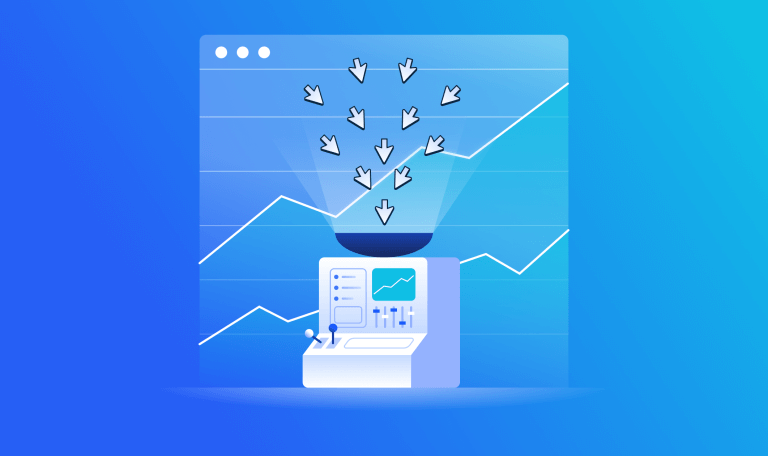7 Proven Strategies to Convert Website Traffic into More Sales

Every single click on your page represents more than mere statistics. Rather, it’s an intersection of potential and action, with each progress driving substantial customer interactions. Imagine how satisfying it is to turn inactive web users into active buyers, driving your business forward. Converting web traffic to sales isn’t a matter of searching for a needle in a haystack. It demands the proper combination of methods, data, and the appropriate use of technology.
Understanding how to convert visitors into customers opens new avenues to long-term customer relationships and increases business success. It lays out different strategies designed to transform your site’s traffic into hard numbers. We’ll discuss common problems while offering practical solutions based on the current digital trends.
Why should you care how much traffic converts into leads and sales?
Your website sits between clicks and revenue opportunities. Every visit, click, and page view is an opportunity to translate curiosity into tangible outcomes that increase revenue and help your business flourish.
Knowing the extent to which your website traffic is converting into sales is useful not only for devising strategic plans but also as a business intelligence tool. Being mindful of this does more than smooth out surface work; it lays the foundations for insightful decisions and strategic planning. There are several reasons this metric matters to you:
Understanding customer acquisition costs
Every dollar spent on marketing needs to have a return. When you tie web traffic to sales results, you determine how efficiently resources are being deployed. This allows you to identify cost-cutting while maximizing returns, thereby providing a competitive advantage in the marketplace. It is about utilizing your budget efficiently to amplify outreach and profitability.
Improving marketing efficiency
To turn more visits into sales means making the most of advertising dollars. It’s about segmenting campaigns to better serve certain target audiences, instead of launching a massive wave. It’s not only on company dashboards that we see this fine-tuned method – it’s an example of the right use of resources to shape and create authentic audience meaningful interaction.
Enhancing customer experience
From interest to purchasing reflects a streamlined user experience. It’s not just about navigating your website correctly but building loyalty through continuous positive interactions after purchasing. Creating improvements on the basis of customer feedback increases trust, strengthens customer relationships, and encourages repeat business.
Accelerating business growth
Conversion metrics are the tactical engineers, sculpting individualized strategies and charting business paths. They teach you how to take advantage of strengths and identify opportunities for growth. Knowing these metrics not only makes the decision possible today but it creates the foundation for ongoing success and growth.
5 reasons your website traffic doesn’t convert
A huge number of website visitors sounds good, but numbers alone don’t guarantee success. The conversion, the sudden shift from browsers to buyers, is what counts. There are many reasons why visitors can just leave without making a purchase. Identifying these elements gives you a head start on how to sustain interest and drive sales:
1. Poor website usability
If your website guides visitors through a never-ending maze, they will leave the page in search of something more simple. Make navigation easy, make design elements simple, and place clear calls to action to help retain visitors. This design effort should satisfy the user’s demand for simplicity and clear access.
2. Mismatched audience targeting
Having visitors is one thing, but reaching out to the right audience is another. Getting people to click on irrelevant keywords often increases bounce rates. Tweaking your targeting allows you to open your pages to highly interested visitors, matched with strong potential prospects instead of those tricked by trivial messaging.
3. Weak call-to-action (CTA)
A call-to-action (CTA) is not just a goodbye handshake, it’s the final straw that seals the deal. Designing CTAs that speak to visitors and make them want to take action is of great importance. Be clear, and offer clear, comprehensible triggers that drive your target audience to desired actions, translating curiosity into commitment.
4. Lack of trust signals
Building online credibility means providing comfort in the face of doubt. The lack of explicit trust signals, such as customer testimonials, could cause potential buyers to hesitate and doubt reliability. Steady transparency with messages such as returns and reviews creates trust and drives the customer to act.
5. Ineffective content strategies
Content reigns when it makes sense and feels right. If your content is off the mark, or if it isn’t answering customer questions, visitor interactivity dwindles. Attracting attention entails crafting material that addresses your target’s real needs, showing them how your product anticipates their problems and challenges.
7 proven ways to turn website traffic into sales
If accumulating a high volume of website traffic is a good thing, the challenge is to translate those numbers into increased sales. Companies that get high traffic can easily find themselves struggling with low conversion rates, which impacts their profitability.
By zeroing in on online behaviors and designing strategies that suit users best, brands can develop strategies that drive shoppers from just simply browsing to buying with confidence. Below are a few tried and tested ways to convert passive traffic into buyers that will improve your financial outcome:
1. Crafting compelling CTAs
A spot-on call to action (CTA) acts as a stimulant, turning user interest into definite actions. Effective CTAs, such as “Join now for exclusive offers” or “Get your exclusive offer today” can significantly influence users to move forward with taking the desired action. Position them strategically throughout your website to smooth the transition from visitor to customer.
2. Utilizing social proof
Trust is an indispensable factor when trying to guide the user into making a purchase. Providing approvals and testimonials from satisfied customers is real social proof. Consumers tend to place their faith in online reviews over direct recommendations. This makes it a great opportunity for potential buyers to act.
3. Enhancing user experience
A fast, smooth, and intuitive browsing experience is of utmost importance to maintaining customer involvement. According to Google, 53% of users will avoid a site that takes more than three seconds to load. With the help of Core Web Vitals optimization, speedy page loading, and frictionless navigation, you’ll keep visitors’ interest, decrease bounce rates, and improve the overall experience.
4. Improving SEO
A potent SEO strategy increases your site’s visibility on search engines and this allows more potential buyers to discover your product offerings. Utilize powerful SEO tools for keyword insight, SERP position monitoring, and perform regular audits to move up your business to higher rankings, garnering organic traffic.
5. Urgency through timed offers
Inducing a sense of urgency with the help of short-term deals and promos can drive instantaneous purchasing decisions. Special offers such as time-limited discounts and countdown clocks can activate the ‘fear of missing out’ (FOMO), encouraging users to complete purchases quickly in order to get those special deals.
6. Leveraging retargeting ads
Keep your brand lingering in the minds of consumers through retargeting ads. These ads reach back out to previous visitors to your site, reminding them of previous interests, and entice them to come back again to carry out the completion of potential purchases.
7. Email marketing campaigns
Individualized emails can slowly bring in buyers to the sales funnel. By segmenting audiences and developing targeted messaging based on their taste and preferences, companies can cultivate strong customer relationships that last beyond the initial sale.
Monitor how much traffic you convert to sales and keep optimizing
If you’re constantly getting visitors, that’s useful, but without sales conversion correlation it won’t be of much use. And that’s where Similarweb helps — with tools to constantly check website traffic, engagement, and conversion data. Using solutions like Website Analysis and Conversion Analytics, Similarweb provides the deep knowledge required to pivot strategies. Here’s how these tools integrate perfectly with your conversion efforts:
Website traffic analysis insights
Through Similarweb’s Website Analysis tool, businesses can learn how to analyze traffic and understand visitor behavior. Firms can access crucial metrics such as visits, device separation, and engagement times through “Traffic and Engagement” insights.
Such information is invaluable for advertisers looking to find where there is room for improvement, increasing conversion rates through upgraded visitor interaction.
Understanding conversion analytics
Similarweb’s Conversion Analysis tool provides an in-depth view of a website’s long-term performance. By monitoring converted visits and conversion rates, businesses can pinpoint growth opportunities or flag downward trends, making proactive adjustments to stay competitive. The tool also reveals which marketing channels drive the highest conversions in specific time frames, enabling a targeted, high-return strategy.
Step 1: Benchmark your website’s conversion rate against competitors
Start by comparing your conversion rate to your competitors over time. This reveals if your performance is on par with industry standards and highlights areas for improvement.
Step 2: Analyze your overall conversion rate against the industry average
Evaluating your conversion rate against both the industry average and competitors clarifies where to focus – whether it’s boosting conversion rates or increasing website traffic.
Step 3: Review and learn from the market Leaders’ conversion rates across channels
Identify companies with exceptional conversion rates and analyze their approaches. Adopting best practices from these market leaders can help improve your own website’s conversion success.
You can look at the top-performing websites and the ones that have experienced the most growth period-over-period (PoP).
With these insights, you can adjust your marketing strategies quickly. Similarweb’s intuitive platform transforms complex data into actionable insights, seamlessly integrating into strategic planning.
Maximize your online impact with confidence
Increasing sales conversions depends on being able to truly know your conversion rates, by understanding your competitors’ performance, and staying updated on industry benchmarks. For this, you need a reliable tool that provides the granular data that matters the most to you.
With top-tier insights and the most accurate data, Similarweb empowers you to unlock valuable conversion metrics, refine your marketing strategies, and optimize budgets for sustainable sales growth.
FAQs
How does conversion rate optimization work?
Conversion rate optimization focuses on increasing the percentage of visitors who take desired actions, like making a purchase. With small tweaks to your site’s elements, you can enhance user experience and systematically boost conversion rates.
What are some methods to boost website traffic?
To grow your traffic, leverage SEO techniques like website optimization, quality content creation, and backlink building. Adding diverse content like blogs and tutorials not only attracts visitors but keeps them engaged, bringing a larger audience to your site.
Does social proof really matter?
Yes, absolutely. Social proof builds trust and directly impacts conversions. Adding testimonials, reviews, and case studies showcases the real value of your offerings, making it easier for hesitant prospects to choose you.
Is mobile optimization really necessary?
Yes, mobile optimization is essential as mobile users continue to rise. A seamless mobile experience keeps users engaged and prevents you from losing a significant market share. It’s key to delivering a smooth, enjoyable user experience on any device.
Should you regularly analyze your website’s traffic?
Regularly reviewing your site’s traffic with tools like Website Intelligence or app analytics gives valuable insights into visitor behavior. Analyzing conversions, bounce rates, and traffic sources helps you refine your tactics to stay in sync with changing user needs.
Your full marketing toolkit for a winning strategy
The ultimate solution to help you build the best digital strategy













